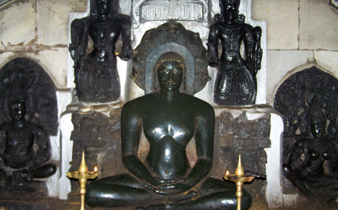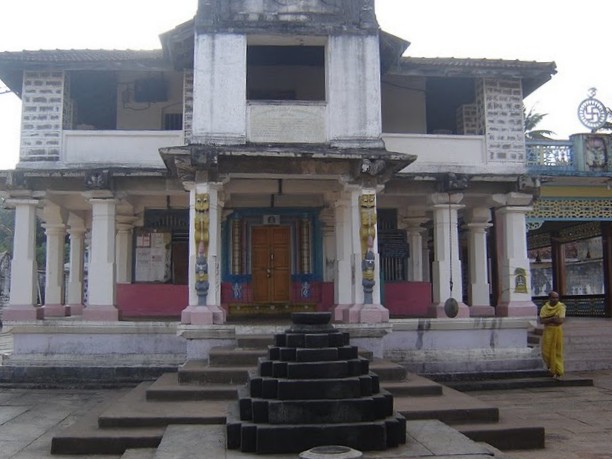Jain Temples at Humcha
Humbaj or Hombuja (better known as Humcha or Hamchawadi) is a Atishaya Kshetra, a place where divine events regularly occur. It is the most famous pilgriage place dedicated to Lord Parsvanath and Devi Padmavati, in India. As per Historians and Jain religios leaders, Humcha or Hombuja is considered as the most sacred place for Mata Padmavati.
This place is situated in state of Karnataka in District Shimoga. Humcha is known for its rich cultural and architectural heritage. Epic and history related to Humcha has been written in 22 stone inscriptions, fornd in various temples in Humcha. This Story has been written on a stone inscription in "Panchkut Basadi", 1077 AD in Sanskrit and Kannada. This story can even be found in a book by name of "Jinduttrai Charitrya" in Kannada by poet Padmanabh, written in 1680AD.
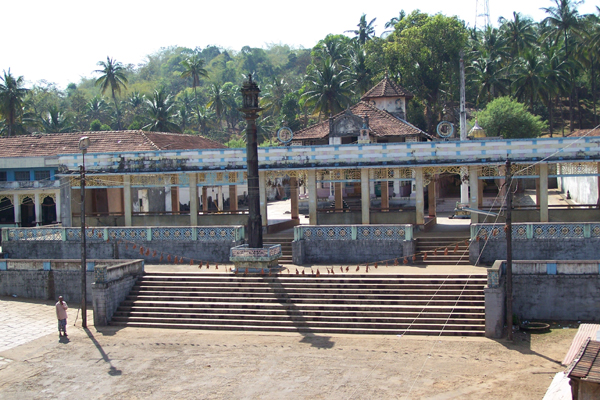
Padmavati temple
Legend related to Humcha
In the region of Sursen, there was a city by name of Mathura, which was ruled by a king named "Rah", who also fought in the battle of Mahabharata, in Kurukshetra. When he was victorious in it, Krishna gifted him with a conch shell and a monkey flag. In the same royal family after a series of generations, there was king by name of, Sahkar. His queen was, Shriyala Devi, both king and queen were follower of Jainism. They were even followers of Jain monk, Muni Sidhantkirti.
The Royal couple had three daughters, and they desperately wanted a son. Out of her worries, queen went to monk, and as per his advice started worshipping Padmavati Mata. Blessed by Mata Padmavati, queen became pregnant and during her pregnancy she saw a dream in which she saw a crane has been separated from the group and entered the a lake. When she narrated the dream to monk, he said she will give birth to a brave and an intelligent son, but when he will be 16 years old there will be lot of troubles on him as a result he will have to settle in some other city. As expected, queen gave birth to a son, who was named as "Jindutt."
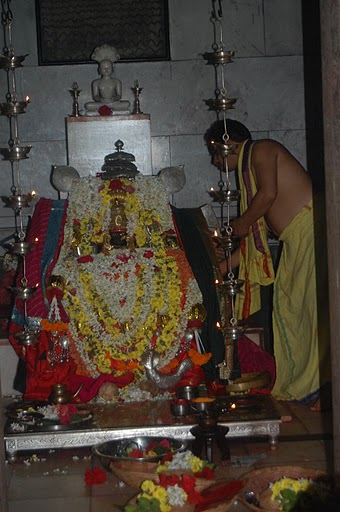
Image of Padmavati Mata beneath a smaller idol of Parshvanath
After few days, King got information that chiefs of the districts have revolted and refused to pay taxes. King went to the monk, to take his blessing to be victorious in the battle. Monk Sidhantkirti warned him that though he will be victorious, but he should not do any deed which will bring shame to his family. As said he became victorious and on returning back he got infatuated with a gorgeous looking lady from the Padmini clan. Despite, advice of his ministers, King wanted to marry the girl, when all their efforts went in vein they called the head of the Shabri race, and requested him to get his daughter married to the king. The Old tribal head, said that it is just an infatuation, but on repeated request, he agreed on a condition that he should give the same love and respect to the son of his daughter as given to any prince. King promised that his daughter's son will only become the crowned prince, and they got married.
King Sahkar, brought the newlywed queen to the state capital, and kept her in a separate palace. Queen Shriyala Devi was very upset with the development of the incidents, and when she met the king, he consoled her and said that he will make Jindutt as crown prince and stay in the separate palace. As said, Jindutt was crowned as the prince and queen became a spinster. King started staying in the shabri palace with the shabri queen and spent all his time there. Slowly and steadily he started consuming liquor and flesh. Once the chef, didn't get any animal for cooking and incidentally there was a body of a human who was hanged that day and he cooked him instead of a animal, king really liked the taste and ordered to kill anybody who is new to city, and cook him for dinner. As a result there was unrest in the whole kingdom, and seeing the revolt from the people chef said that he is incapable to collect flesh for him, and said that if u send anybody to him with lemons in his hand he will kill and cook, the carrier of lemons.
Ministers felt the unrest in the kingdom and advised King to crown Jindutt as King, and Sahkar agreed to the same, when queen shabri came to know of the same she said he has cheated her. King said he has given a separate kingdom to her son "Maridutt", and then also she didn't agree and said that Jindutt is conspiring to revolt against King Shakar. Ultimately, he planned to kill Jindutt, and to do the same he called him and ordered him to go and give the lemons to the chef. Luckily, midway he met Maridutt, who took lemons from Jindutt and headed to the kitchen. As instructed by the king, chef killed Maridutt, and cooked his flesh for dinner and offered the same to the King and Queen.
When King enquired about the absence of Maridutt, the chef narrated the whole incident. King became ferocious and ordered his Army to go and kill Jindutt. When Kings former wife came to know of the whole incident, she took her son and went to Monk Sidhantkirti ji, who suggested them to leave the kingdom as early as possible and take a horse form the stable, who is standing with right foot lifted up in air, and take the idol of "Ma Padmavati" with them, and if in case the Army approaches you, just show them idol to them, and this idol will cure all their miseries.

Jain math
Jindutt bid goodbye to his mother and left, following him as soon as the troops approached him, he showed the idol as instructed, by the Monk. On seeing the idol all the people in Army fainted and were not able to catch, Jindutt. He headed towards south direction. One day while moving, he got really tired and hanged the idol of Ma Padmavati on the Lakki tree and fell asleep. In his slumber, he got a dream, in which the goddess instructed him to settle here only, all the local people will help him, and Iron will turn into gold, if he will touch it with the feet of the idol, which will help him make this place as his capital city. When he woke he was not able to believe on his dream, and then he tried to pick up the idol but all his efforts were in vain. This made him believe that this might be true, then all locals welcomed him and with converted gold he made this place as his capital. He got a Parsvanath Temple and a Padmavati Temple constructed at that place. Then Monk Siddhantkirti and his mother also settled in this place. Then Jindutt got married to the princess of the kingdom of South Mathura, named Manoradhini.
After so many years of happy ruling by Jindutt, goddess thought of testing Jindutt, she created two pearls in this pond, One pearl was pure and another had some stain. Someone found these pearls and honestly surrendered them to king. King Jindutt got two nose rings prepared using these pearls. He presented the jewel with the pure pearl to his queen and the stained one to the goddess.
Next day when he went to the Temple to worship the goddess, he was shocked when he say the nose ring which he had presented to his wife was there in goddess nose, he realized his mistake. Then only there was a heavenly voice which said to Jindutt that, "It is not your fault, the time is such, your father after falling in love committed all sins and got his own son killed, and now you are following the same path. Now I won't stay here, and my idol which converts Iron into Gold will go down the well." On hearing this Jindutt realized his mistake and started pleading for forgiveness, afterwards again the heavenly voice said, "Place another idol of me here, and I will keep on blessing my disciples over here, and my presence can be felt here in form of four miracles:
- The Lakki Tree behind the idol will never dry.
- The Moti Lake will always have water even in case of severe drought.
- At the Origin of "Kumudvati River" water will always keep on flowing.
- Whenever my blessing will there on a disciple, for a particular wish, "a flower will fall from my right side".

Jain math
The Bhattaraka tradition at Humcha
In the fourfold division. of the Jaina society consisting of shravakas (male laity), shravikas (female laity), sadhus (monks) and sadhvis (nuns), the Bhattaraka, a specific Digambar institution, is placed above the laity but below the ascetics. He resides in a permanent domicile called matha and is committed to living a celibate life. He uses, like a fully ordained monk, a fly-whisk made of peacock feathers but wears three pieces of clothing. However, he need not pluck his hair and may travel by any kind of transport. Unlike a full monk, a Bhattaraka wears an orange robe, stays in a single place and is involved in management of assets of the institution.
His main duties lie in the fields of education, social and 'medical welfare, in fostering amity among the members of the community, and in keeping religious rites and traditions alive. Further, he is expected to be well versed in matters of doctrines and sacred law as well as being an able administrator and negotiator when it comes to settling disputes. Bhattaraka illuminates both dharmas, is an expert in all scriptures, has the authority to recite the suri-mantra (to consecrate an image). He is also responsible for preserving the order. He is the head of the six limbs of the sangh: shravaka, shravika, pandita (bramha), muni (vrati), aryika and Bhattaraka.
Traditionally, a Bhattaraka nominates his successor, almost always from among his disciples. If for any reason he fails to do that, a committee of lay-people will select a new Bhattaraka. When death approaches, the custom prevails that a Bhattaraka will discard his three pieces of clothing, so that he may die the death of an ordained monk, that is naked.
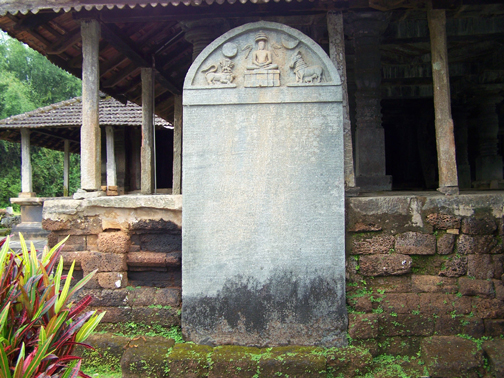
Stone inscription at the entrance of the Jain math
The Bhattaraka seat at Humcha was founded in the 8th century AD, during the reign of Jinadatta Rai, founder of the ruling dynasty of Santar. In 1048 AD, the Mahamandaleshwara Chandarayarus made a donation to a Bhattaraka of Balagara-gana at Balligame near Banavasi in present-day Karnataka. Thus, the Bhattaraka seat at Humcha may be one of the oldest of its kind.
The most widespread Bhattaraka order has historically been the Mula Sangh-NandiSangh-Balatkara Gana-SaraswatiGachchha (MNBS) order. There are perhaps hundreds of thousands of Tirthankara idols, spread across the country from Surat to Decca (in Bangladesh), bearing inscriptions mentioning this order. Most of these idols were installed by the Bhattarakas of this order in the past 7-8 centuries. Many of these Bhattarakas were great scholars and prolific authors.
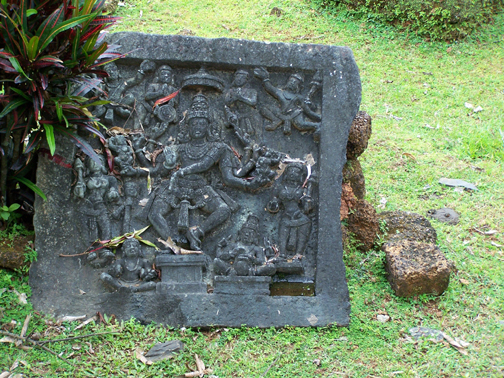
Bas-relief of a dancing god
The ancient institution at Humcha is the original home of the MNBS order. It is headed by Bhattaraka Devendrakirti. He is the only existing Bhattaraka of the MNBS order, several Jain organizations are run by the institute at Humcha
The present Bhattaraka of Humcha who bears the title Devendrakirthi Swamigal was traditionally chosen by his predecessor and installed in 1971 at the age of twenty- two. He is both an able conservator of Jaina traditions and values as well as an enterprising innovator in fields such as education and social welfare, and he is one of the as yet small number of Jainas who take an active interest in making Jainism better known in the world.
